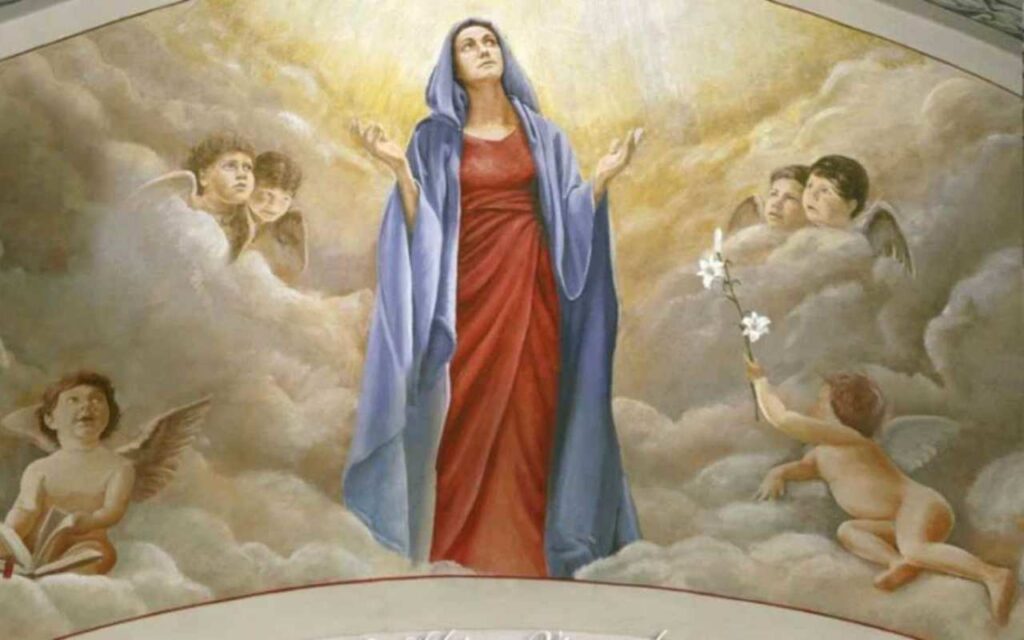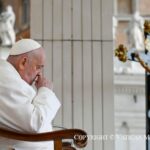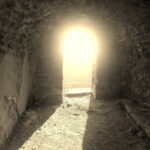Tempo di lettura: 10 minuti
Assumption of the Blessed Virgin Mary: history
Summary
The solemnity of the Assumption of the Blessed Virgin Mary è fissata il 15 agosto già nel V secolo, con il senso di “Nascita al cielo” o, nella tradizione bizantina, “Dormizione”. A Roma la festa viene celebrata dalla metà del VII secolo, ma si dovrà aspettare il 1° novembre 1950, con Pio XII, per la proclamazione del dogma dedicato a Maria assunta in cielo in corpo e anima. Nel Credo apostolico, professiamo la nostra fede nella “Risurrezione della carne” e nella “vita eterna”, fine e senso ultimo del cammino della vita.
Questa promessa di fede, è già compiuta in Maria, quale “segno di consolazione e di sicura speranza” (Prefazio). Un privilegio, quello di Maria, strettamente legato al fatto di essere Madre di Gesù: dato che la morte e la corruzione del corpo umano sono conseguenza del peccato, non era opportuno che la Vergine Maria – esente dal peccato – fosse intaccata a questa legge umana. Da qui, il mistero della “Dormizione” o “Assunzione in cielo”. Il fatto che Maria sia già assunta in cielo, è per noi motivo di letizia, di gioia, di speranza: “Già e non ancora”. Una creatura di Dio – Maria – è già in cielo: con e come lei, anche noi, creature di Dio, un giorno lo saremo.
Il destino di Maria, unita al corpo trasfigurato e glorioso di Gesù, sarà dunque il destino di tutti coloro che sono uniti al Signore Gesù nella fede e nell’amore. Interessante notare che la liturgia – attraverso i testi biblici tratti dal libro dell’Apocalisse e di Luca, con il canto del Magnificat – miri a farci non tanto riflettere quanto pregare: il vangelo infatti suggerisce di leggere il mistero di Maria alla luce della sua preghiera, il Magnificat: l’amore gratuito che si estende di generazione in generazione, e la predilezione per gli ultimi e i poveri trova in Maria il frutto migliore, si potrebbe dire il suo capolavoro, specchio nel quale l’intero popolo di Dio può riflettere i propri lineamenti.
La solennità dell’Assunzione della beata Vergine Maria, in corpo e anima, è il segno eloquente di quanto non solo “l’anima” ma anche la “corporeità” si confermi una “cosa molto bella” (Gn 1,31), tanto che, come nella Vergine Maria, la “nostra carne” sarà assunta in cielo. Questo non ci esula dall’impegnarci nella storia, anzi: proprio lo sguardo rivolto alla Meta, al Cielo, la nostra Patria, spinge a impegnarsi nella vita presente sul solco del Magnificat: lieti per la misericordia di Dio, attenti ai fratelli e sorelle tutti che s’incontra lungo il cammino, a cominciare dai più deboli e fragili.

The proclamation of the Dogma
“Pertanto, dopo avere innalzato ancora a Dio supplici istanze, e avere invocato la luce dello Spirito di Verità, a gloria di Dio onnipotente, che ha riversato in Maria vergine la sua speciale benevolenza a onore del suo Figlio, Re immortale dei secoli e vincitore del peccato e della morte, a maggior gloria della sua augusta Madre e a gioia ed esultanza di tutta la chiesa, per l’autorità di nostro Signore Gesù Cristo, dei santi apostoli Pietro e Paolo e Nostra, pronunziamo, dichiariamo e definiamo essere dogma da Dio rivelato che: l’immacolata Madre di Dio sempre vergine Maria, terminato il corso della vita terrena, fu assunta alla gloria celeste in anima e corpo” (Pio XII; Munificentissimus Deus, 1 novembre 1950)
Give praise
Oggi la Vergine Maria, col suo Magnificat, c’insegna a rendere lode e gloria a Dio. Un invito attraverso il quale la Vergine Maria, oggi contemplata nella gloria, c’invita a fare uscendo fuori dal nostro solito ingigantire i problemi e le difficoltà. Maria è capace, e oggi lo insegna anche a noi, a guardare alla vita da un’altra angolatura: il nostro cuore è più grande dei nostri peccati, e anche se il nostro cuore ci condanna, Dio è più grande del nostro cuore! (cfr 1Gv 3,20).
Non si tratta quindi di illusione, come se non ci fossero problemi nella vita, ma si tratta di valorizzare il bello e il bene che c’è nella vita e saper rendere grazie a Dio per questo! In questo modo, anche i problemi si relativizzano.
God surprises
Un secondo aspetto che merita essere segnalato in questo giorno, è il fatto che Maria era vergine ed Elisabetta sterile. Dio è Colui che va “oltre”, che ti sorprende per la sua provvidente azione di salvezza.
The goal
Maria è ormai nella gloria di Dio, è giunta alla Meta lì dove un giorno tutti ci ritroveremo. Ecco perché Maria è oggi segno di consolazione di speranza, perché se lei, creatura come noi, è giunta, potremmo giungervi anche noi. Teniamo fisso lo sguardo e il cuore a Colei che non ha mai abbandonato il suo Figlio Gesù e con Lui oggi gode la gioia e la gloria del Cielo.
E affidiamoci a Lei affinché ci aiuti a percorrere la via della vita sapendo riconoscere le grandi cose che Dio compie in noi e attorno a noi, per saperlo magnificare con il canto della nostra esistenza.
Prayer to Maria Assunta
O Mary Immaculate Assumed into heaven,
tu che vivi beatissima nella visione di Dio:
di Dio Padre che fece di te alta creatura, di Dio Figlio che volle da te
essere generato uomo e averti sua madre, di Dio Spirito Santo che in te
fulfilled the human conception of the Savior.
O most pure Mary
o Mary sweet and beautiful
o Maria strong and thoughtful woman
o poor and painful Mary
o Mary virgin and mother
very human woman like Eva more than Eva.
Vicina a Dio nella tua grazia nei tuoi privilegi
in your mysteries
in your mission in your glory.
O Maria assunta nella gloria di Cristo
in the complete and transfigured perfection of our human nature.
O Mary door of heaven
mirror of divine light
santuario dell’Alleanza tra Dio e gli uomini,
let our souls fly after you
let them ascend after your radiant path
transported by a hope that the world does not have that of eternal bliss.
Comfort us from heaven or merciful Mother and in your ways
of purity and hope guide us one day to the blessed meeting with you
e con il tuo divin Figlio
il nostro Salvatore Gesù. Amen!
(Saint Paul VI)
source © Vatican News – Dicasterium pro Communicatione
L’Assunzione di Maria in Cielo è un dogma cattolico che afferma che Maria, madre di Gesù, al momento della sua morte (“Dormition of Mary”) immediately moved, both in soul and body, to Paradise, where he was “assumed”, that is, received, accepted.
"It was convenient– writes St. John Damascene –che colei che nel parto aveva conservato integra la sua verginità conservasse integro da corruzione il suo corpo dopo la morte. Era conveniente che colei che aveva portato nel seno il Creatore fatto bambino abitasse nella dimora divina. Era conveniente che la Sposa di Dio entrasse nella casa celeste. Era conveniente che colei che aveva visto il proprio figlio sulla Croce, ricevendo nel corpo il dolore che le era stato risparmiato nel parto, lo contemplasse seduto alla destra del Padre. Era conveniente che la Madre di Dio possedesse ciò che le era dovuto a motivo di suo figlio e che fosse onorata da tutte le creature quale Madre e schiava di Dio".
Mary appears for the last time in the writings of the New Testament in the first chapter of Acts vers. 14"Tutti questi erano assidui e concordi nella preghiera, insieme con alcune donne e con Maria, la madre di Gesù e con i fratelli di lui.” She is in the midst of the apostles, in prayer in the upper room, awaiting the descent of the Holy Spirit.
Alla concisione dei testi ispirati, fa riscontro l’abbondanza di notizie sulla Madonna negli scritti apocrifi, soprattutto il Protovangelo di Giacomo e la Narrazione di S. Giovanni il teologo sulla dormizione della santa Madre di Dio. Il termine “dormizione” è il più antico che si riferisca alla conclusione della vita terrena di Maria.
In the East, towards the fifth century, the Marian cult began among Christians and the Monophysite Eastern churches (of the Armenian and Coptic peoples) under the name "Dormitio virginis”, strengthened in its propagation by the emperor Maurice (582-602) who ordered its celebration throughout the Empire; in the West it arrived in Spain and Gaul in the sixth century, and in Rome in 650 it was celebrated on August 15 with the name of Dormitio or Assumption.
A "constitutum” of S. Sergio I (687-701) speaks of the feast of the dormitio for which a solemn procession was made.
This custom spread with St. Leo IV (847-855) who had the vigil and octave celebrated.
La definizione dogmatica, pronunciata dal Venerabile Pio XII (Eugenio Pacelli, 1939-1958) il 1° novembre del 1950, dichiarando che Maria non dovette attendere, al pari delle altre creature, la fine dei tempi per fruire anche della redenzione corporea, ha voluto mettere in rilievo il carattere unico della sua santificazione personale, poiché il peccato non ha mai offuscato, neppure per un solo istante, la limpidezza della sua anima. L’unione definitiva, spirituale e corporea, dell’uomo con il Cristo glorioso, è la fase finale ed eterna della redenzione. Così i beati, che già godono della visione beatifica, sono in un certo senso in attesa del compimento della redenzione, che in Maria era già avvenuta con la singolare grazia della preservazione dal peccato.
In the light of this doctrine, which has its foundation in Sacred Scripture, in the so-called "Protoevangelium”, contenente il primo annunzio della salvezza messianica dato da Dio ai nostri progenitori dopo la colpa, Maria viene presentata come nuova Eva, strettamente unita al nuovo Adamo, Gesù.
Gesù e Maria sono infatti associati nel dolore e nell’amore per riparare la colpa dei nostri progenitori. Maria è dunque non solo madre del Redentore, ma anche sua cooperatrice, a lui strettamente unita nella lotta e nella decisiva vittoria. Quest’intima unione richiede che anche Maria trionfi, al pari di Gesù, non soltanto sul peccato, ma anche sulla morte, i due nemici del genere umano. E come la redenzione di Cristo ha la sua conclusione con la risurrezione del corpo, anche la vittoria di Maria sul peccato, con la Immacolata Concezione, doveva essere completa con la vittoria sulla morte mediante la glorificazione del corpo, con l’assunzione, poiché la pienezza della salvezza cristiana è la partecipazione del corpo alla gloria celeste.
From the homily of Pope Benedict XVI (Castel Gandolfo, 15 August 2008)
Dear brothers and sisters,
torna ogni anno, nel cuore dell’estate, la Solennità dell’Assunzione della Beata Vergine Maria, la più antica festa mariana. […]
Chiediamo a Maria di farci quest’oggi dono della sua fede, quella fede che ci fa vivere già in questa dimensione tra finito e infinito, quella fede che trasforma anche il sentimento del tempo e del trascorrere della nostra esistenza, quella fede nella quale sentiamo intimamente che la nostra vita non è risucchiata dal passato, ma attratta verso il futuro, verso Dio, là dove Cristo ci ha preceduto e dietro a Lui, Maria.
Looking at Our Lady of the Assumption we understand better that our everyday life, though marked by trials and difficulties, flows like a river towards the divine ocean, towards the fullness of joy and peace. We understand that our dying is not the end, but the entry into life that knows no death. Our setting on the horizon of this world is a resurgence at the dawn of the new world, of the eternal day.
"Mary, as you accompany us in the effort of our daily living and dying, keep us constantly oriented towards the true homeland of bliss. Help us do as you did".
Cari fratelli e sorelle, cari amici che questa mattina prendete parte a questa celebrazione, facciamo insieme questa preghiera a Maria. Davanti al triste spettacolo di tanta falsa gioia e contemporaneamente di tanto angosciato dolore che dilaga nel mondo, dobbiamo imparare da Lei a diventare noi segni di speranza e di consolazione, dobbiamo annunciare con la vita nostra la risurrezione di Cristo.
"Aiutaci tu, Madre, fulgida Porta del cielo, Madre della Misericordia, sorgente attraverso la quale è scaturita la nostra vita e la nostra gioia, Gesù Cristo. Amen".
source © vangelodelgiorno.org





